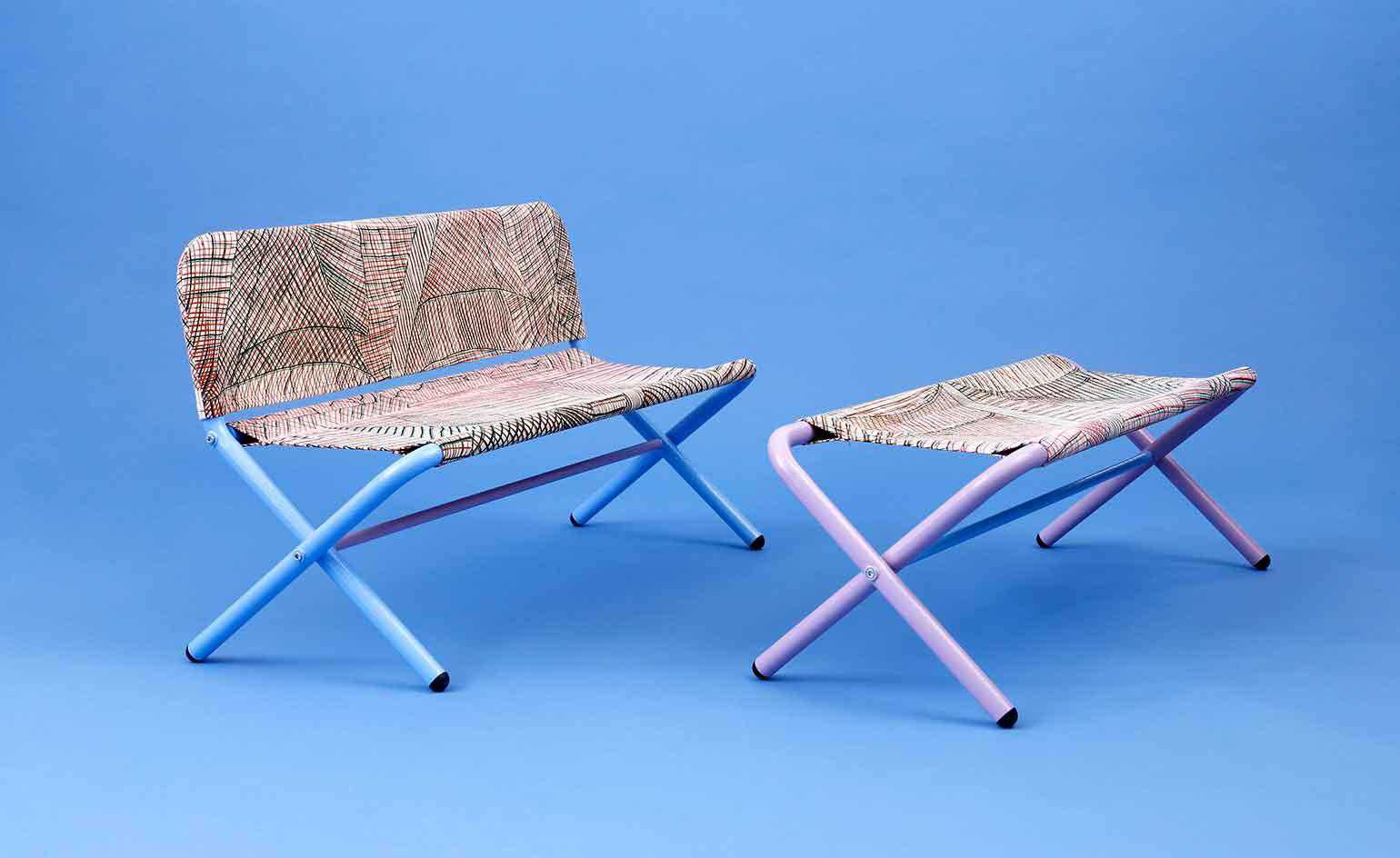Aboriginal textile artists take a seat at the table
31 October, 2021

Textile works by Aboriginal and Torres Strait Islander artists are having a well-deserved moment in Australia’s fashion industry, but this series of new pieces commissioned for the Tarnanthi Art Fair demonstrate that inroads are being made into the furniture world too.
For ‘Rekkan / Tamuwu / Nyinakat (sit/sit down)’, South Australian studio and gallery JamFactory has paired three First Nations textile artists, working from arts centres around the Northern Territory, with furniture designers based in Adelaide, on Kaurna Country.
Collaborative furniture designs
The shapes are eclectic and the palette is bold, from the light touch of Ndjébbana-Kuninjku artist Raylene Bonson’s ‘Love Bench’ collaboration with design duo Daniel To and Emma Aiston – an elevated twist on fold-out camping furniture – to Caren Elliss and Luritja-Pintupi artist Keturah Nangala Zimran’s more lounge-ready ‘Boulder Chair’.
For the ‘Love Bench’, To and Aiston (who run their own design studio, Daniel Emma, in addition to serving as JamFactory’s creative directors) sought to create a ‘utilitarian object that could be transported with ease’, while also complementing the story of an ancestral river-crossing told through Bonson’s linework.
‘Inspired by and wanting to reflect life in and around Maningrida [Bonson’s home], we designed two foldable, functional benches that celebrate the true nature of the Wubbunj (paperbark canoe) which Raylene’s silkscreen fabric depicts,’ the pair explain of their pastel-coloured steel frame. ‘We really liked the concept of the piece actually being used, especially on Country as an everyday, useful object.’
Zimran’s vivid block colours and curved shapes illustrate the rocks and dunes of her home in the central desert. Printed onto linen and stretched over Australian Blackwood by Elliss, the plump armchair and footrest set evokes the soft-hard duality of the landscape, while mirroring the geology of its upholstery.
Sandwiched between smooth panels of Tasmanian Oak by designer Dean Toepfer, Tiwi artist Roslyn Orsto’s Punarika (waterlily) pattern celebrates the waterways and life cycles of the Tiwi Islands, just north of the mainland.
In passing, the bright colours and shapes seen across the collection might seem to evoke the kind of day-glo Australiana that non-Indigenous artists like Ken Done made famous in the 1980s. But these pieces tap into something that runs deeper – and continues to evolve.
‘“Australian design” is nothing without the input of First Nations people,’ say To and Aiston of the exchange of knowledge and skills at the heart of the collection. ‘Without this, it simply becomes a single-layered story.’
For ‘Rekkan / Tamuwu / Nyinakat (sit/sit down)’, South Australian studio and gallery JamFactory has paired three First Nations textile artists, working from arts centres around the Northern Territory, with furniture designers based in Adelaide, on Kaurna Country.
Collaborative furniture designs
The shapes are eclectic and the palette is bold, from the light touch of Ndjébbana-Kuninjku artist Raylene Bonson’s ‘Love Bench’ collaboration with design duo Daniel To and Emma Aiston – an elevated twist on fold-out camping furniture – to Caren Elliss and Luritja-Pintupi artist Keturah Nangala Zimran’s more lounge-ready ‘Boulder Chair’.
For the ‘Love Bench’, To and Aiston (who run their own design studio, Daniel Emma, in addition to serving as JamFactory’s creative directors) sought to create a ‘utilitarian object that could be transported with ease’, while also complementing the story of an ancestral river-crossing told through Bonson’s linework.
‘Inspired by and wanting to reflect life in and around Maningrida [Bonson’s home], we designed two foldable, functional benches that celebrate the true nature of the Wubbunj (paperbark canoe) which Raylene’s silkscreen fabric depicts,’ the pair explain of their pastel-coloured steel frame. ‘We really liked the concept of the piece actually being used, especially on Country as an everyday, useful object.’
Zimran’s vivid block colours and curved shapes illustrate the rocks and dunes of her home in the central desert. Printed onto linen and stretched over Australian Blackwood by Elliss, the plump armchair and footrest set evokes the soft-hard duality of the landscape, while mirroring the geology of its upholstery.
Sandwiched between smooth panels of Tasmanian Oak by designer Dean Toepfer, Tiwi artist Roslyn Orsto’s Punarika (waterlily) pattern celebrates the waterways and life cycles of the Tiwi Islands, just north of the mainland.
In passing, the bright colours and shapes seen across the collection might seem to evoke the kind of day-glo Australiana that non-Indigenous artists like Ken Done made famous in the 1980s. But these pieces tap into something that runs deeper – and continues to evolve.
‘“Australian design” is nothing without the input of First Nations people,’ say To and Aiston of the exchange of knowledge and skills at the heart of the collection. ‘Without this, it simply becomes a single-layered story.’
